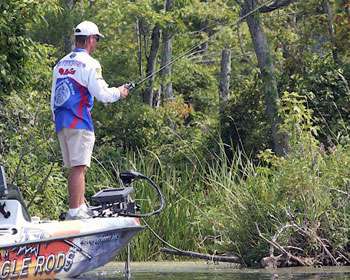
When it comes to flipping and pitching, noted power fisherman Terry Butcher is a force to be reckoned with.
The Elite Series pro who hails from Oklahoma has cashed numerous checks over the course of his career by tackling some of the thickest cover on the lake. The term "slop" can mean a lot of different things but Butcher uses it mostly to describe success.
In the final stop on the 2009 Bassmaster Elite Series regular season on Oneida Lake, where Butcher finished 10th, several of his key bass came by way of flipping shallow grass clumps and debris that created a slop canopy. "Most of my game plan up there was about fishing in the sloppiest water I could find," he says. "Those largemouth at Oneida get so shallow that just about any little piece of grass you could find that was floating along the bank could hold a fish."
Bass, Butcher points out, will often congregate under these floating mats of grass, wood and junk and use it as a canopy, providing the perfect opportunity for power fishing. "Sometimes all it takes is for some floating grass to blow into a bank," Butcher explains. "You might have a strip of bank, no more than 2 feet wide that just seems to grab anything that floats by. Those are areas that I'll always target because bass just love to have cover like that."
Butcher explains that his preferred setup for fishing the slop is a heavy, 1-ounce Tungsten weight pegged ahead of a Texas rigged creature bait. "Most of the time, I treat slop fishing just like I would treat fishing grass mats," he explains. "Just like fishing a grass mat, most of the time when that big weight punches through the slop, a bass will swim off with it."
In most cases, slop gathers in very shallow water. As such, Butcher points out that anglers might consider the 1-ounce weight to be overkill. "You might wonder how a bass can grab something that big so quickly when they're in such shallow water. I promise that you'd be amazed at how fast a bass will react when the bait breaks through the slop."
In water deeper than 3 feet, a slower "yo-yo" retrieve often produces for Butcher. "I like to let the bait punch through the slop and hit the bottom. Then I'll slowly pull it back up towards the top of the mat," he explains. "You have to be really careful to not hit the underside of the canopy when doing this because it will stir everything up." If the slow pull doesn't elicit a strike, Butcher will employ a final tactic before moving on. "If they won't hit it on the initial fall, or after I've brought it up a couple of times, I'll pull it right to the edge of the slop and shake my bait with the rod tip.
Sometimes it's just too much for a bass to resist," he explains. Often, a small pocket covered in slop will have several large features, such as a partially submerged dock or floating log, that stand out from the smaller pieces of debris.
While the larger objects may appear to be an obvious target, Butcher explains they're not always prime for holding the bass. "I like to focus on the smaller stuff," he says. "I know that it seems odd, but I haven't had that much success punching around the larger pieces of debris. I've always had more success focusing on the smaller pieces of slop that are as close to the bank as possible."
(Provided by Z3 Media)




